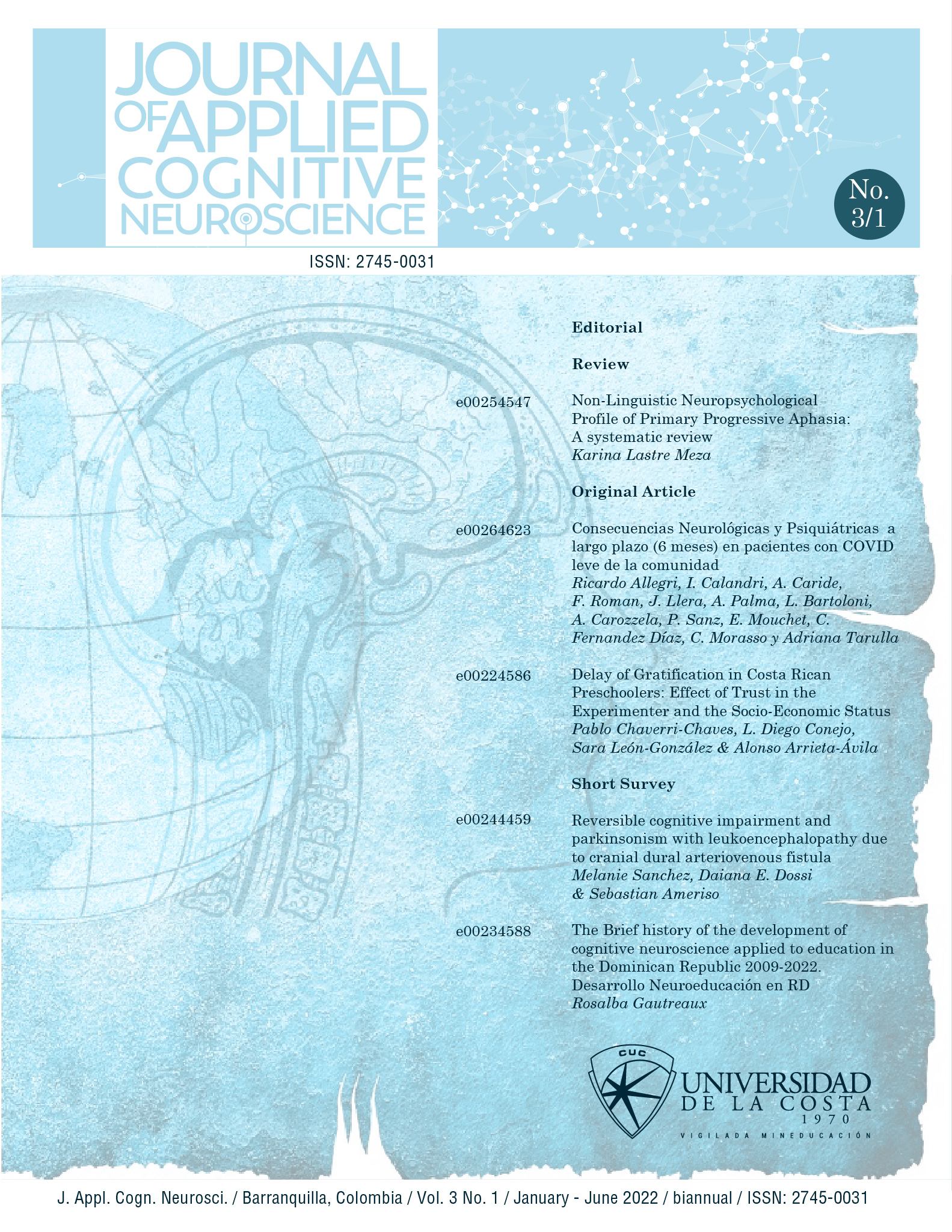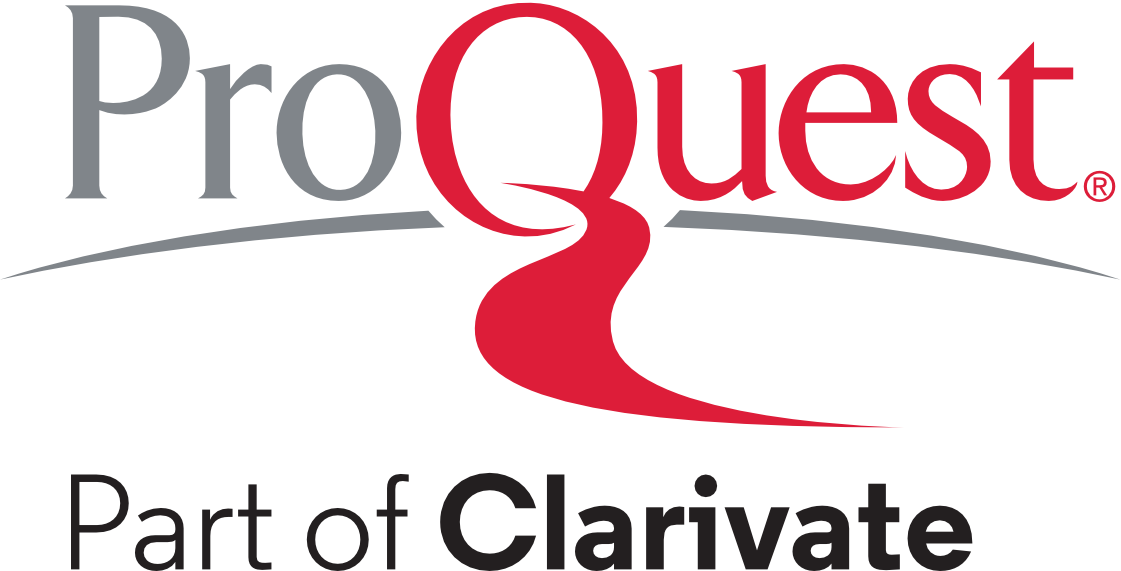Delay of Gratification in Costa Rican Preschoolers: Effect of Trust in the Experimenter and the Socio-Economic Status
Postergación de la gratificación en preescolares costarricenses: efecto de la confianza en el experimentador y el estatus socioeconómico
DOI:
https://doi.org/10.17981/JACN.3.1.2022.04Palabras clave:
self-control , preschoolers , delay of gratification , candy test , decision makingResumen
Este estudio analizó el efecto de la confianza en la persona experimentadora sobre el desempeño de un grupo de niñas(os) preescolares costarricenses en el autocontrol. Adicionalmente, se analizó el efecto del estatus socioeconómico en el desempeño en la tarea de la golosina por medio de una comparación de niños provenientes tanto de diferentes escuelas (pública vs privada) como de distintos contextos socioeconómicos al interior de cada escuela. La muestra de participantes fue de 67 niños(as) (26 niñas, M de edad = 63 meses, D.T. = 6.03). Se encontraron efectos, tanto de la confianza en la persona experimentadora, como del contexto socioeconómico en el autocontrol. Se discuten las implicaciones de este estudio para futuros trabajos con niñas y niños, y familias.
Descargas
Citas
Beran, M. J. (2018). Self-control in animals and people. Academic Press.
Brito, N. H.; Piccolo, L. R. & Noble, K. G. (2017). Associations between cortical thickness and neurocognitive skills during childhood vary by family socioeconomic factors. Brain and Cognition, 116, 54–62.
https://doi.org/10.1016/j.bandc.2017.03.007
Chaverri, P.; Barrantes, R. & Conejo, D. (2021). El test de la golosina en contexto: ¿cómo influye el entorno social en la toma de decisiones y el autocontrol? Ciencias Psicológicas, 15(2), 1–11.
https://doi.org/10.22235/cp.v15i2.2486
Cecchini, S. & Martínez C., R. (2011). Protección social inclusiva en América Latina: Una mirada integral, un enfoque de derechos (1. ed). Organización de las Naciones Unidas; Comisión Económica para América Latina y el Caribe-CEPAL.
Denison, S. & Xu, F. (2010). Twelve- to 14-month-old infants can predict single-event probability with large set sizes: Twelve- to 14-month-olds can predict single-event probability. Developmental Science, 13(5), 798–803.
https://doi.org/10.1111/j.1467-7687.2009.00943.x
Diamond, A. (2013). Executive Functions. Annual Review of Psychology, 64(1), 135–168.
https://doi.org/10.1146/annurev-psych-113011-143750
Doebel, S.; Michaelson, L. E. & Munakata, Y. (2019). Good Things Come to Those Who Wait: Delaying Gratification Likely Does Matter for Later Achievement (A Commentary on Watts, Duncan, & Quan, 2018). Psychological Science, 31(1), 97–99.
https://doi.org/10.1177/0956797619839045
Farah, M. J.; Shera, D. M.; Savage, J. H.; Betancourt, L.; Giannetta, J. M.; Brodsky, N. L.; Malmud, E. K. & Hurt, H. (2006). Childhood poverty: Specific associations with neurocognitive development. Brain Research, 1110(1), 166–174.
https://doi.org/10.1016/j.brainres.2006.06.072
Gergely, G.; Bekkering, H. & Király, I. (2002). Rational imitation in preverbal infants. Nature, 415(6873), 755–755.
https://doi.org/10.1038/415755a
Gopnik, A.; Glymour, C.; Sobel, D. M.; Schulz, L. E.; Kushnir, T. & Danks, D. (2004). A Theory of Causal Learning in Children: Causal Maps and Bayes Nets. Psychological Review, 111(1), 3–32.
https://doi.org/10.1037/0033-295X.111.1.3
Gweon, H. & Schulz, L. (2011). 16-Month-Olds Rationally Infer Causes of Failed Actions. Science, 332(6037), 1524–1524.
https://doi.org/10.1126/science.1204493
Hackman, D. A. & Farah, M. J. (2009). Socioeconomic status and the developing brain. Trends in Cognitive Sciences, 13(2), 65–73.
https://doi.org/10.1016/j.tics.2008.11.003
Holland, M. L.; Condon, E. M.; Younts, C. W. & Sadler, L. S. (2019). Birth outcomes of second children after community-based home visiting: A research protocol. Research in Nursing & Health, 42(2), 96–106.
https://doi.org/10.1002/nur.21931
Ihaka, R. & Gentleman, R. (2022). R (version 4.1.3). [Software]. R Development Core Team.
Johnson, S. B.; Riis, J. L. & Noble, K. G. (2016). State of the Art Review: Poverty and the Developing Brain. Pediatrics, 137(4), 1–16.
https://doi.org/10.1542/peds.2015-3075
Kia-Keating, M.; Nylund-Gibson, K.; Kia-Keating, B. M.; Schock, C. & Grimm, R. P. (2018). Longitudinal Patterns of Self-Regulation among Ethnic Minority Children Facing Poverty. Journal of Child and Family Studies, 27(2), 398–411.
https://doi.org/10.1007/s10826-017-0883-5
Kidd, C.; Palmeri, H. & Aslin, R. N. (2013). Rational snacking: Young children’s decision-making on the marshmallow task is moderated by beliefs about environmental reliability. Cognition, 126(1), 109–114.
https://doi.org/10.1016/j.cognition.2012.08.004
Lahti, M.; Evans, C. B. R.; Goodman, G.; Schmidt, M. C. & LeCroy, C. W. (2019). Parents as Teachers (PAT) home-visiting intervention: A path to improved academic outcomes, school behavior, and parenting skills. Children and Youth Services Review, 99, 451–460.
https://doi.org/10.1016/j.childyouth.2019.01.022
Lamm, B.; Keller, H.; Teiser, J.; Gudi, H.; Yovsi, R. D.; Freitag, C.; Poloczek, S.; Fassbender, I.; Suhrke, J.; Teubert, M.; Vöhringer, I.; Knopf, M.; Schwarzer, G. & Lohaus, A. (2018). Waiting for the second treat: Developing culture-specific modes of self-regulation. Child Development, 89(3), e261–e277.
https://doi.org/10.1111/cdev.12847
Lawson, G. M.; Hook, C. J. & Farah, M. J. (2018). A meta-analysis of the relationship between socioeconomic status and executive function performance among children. Developmental Science, 21(2), 1–22.
https://doi.org/10.1111/desc.12529
Lee, W. S. C. & Carlson, S. M. (2015). Knowing When to Be “Rational”: Flexible Economic Decision Making and Executive Function in Preschool Children. Child Development, 86(5), 1434–1448.
https://doi.org/10.1111/cdev.12401
Luerssen, A.; Gyurak, A.; Ayduk, O.; Wendelken, C. & Bunge, S. A. (2015). Delay of gratification in childhood linked to cortical interactions with the nucleus accumbens. Social Cognitive and Affective Neuroscience, 10(12), 1769–1776.
https://doi.org/10.1093/scan/nsv068
Mair, P. & Wilcox, R. (2020). WRS2: A Collection of Robust Statistical Methods (version 1.1-0).
https://CRAN.R-project.org/package=WRS2
McClure, S. M.; Laibson, D. I.; Loewenstein, G. & Cohen, J. D. (2004). Separate Neural Systems Value Immediate and Delayed Monetary Rewards. Science, 306(5695), 503–507.
https://doi.org/10.1126/science.1100907
McCoy, D. C. & Raver, C. C. (2014). Household instability and self-regulation among poor children. Journal of Children and Poverty, 20(2), 131–152.
https://doi.org/10.1080/10796126.2014.976185
Miller, E. K.; Freedman, D. J. & Wallis, J. D. (2002). The prefrontal cortex: Categories, concepts and cognition. Philosophical Transactions of the Royal Society of London. Series B: Biological Sciences, 357(1424), 1123–1136.
https://doi.org/10.1098/rstb.2002.1099
Mischel, W. (1974). Processes in Delay of Gratification. L. Berkowitz (Ed.), Advances in Experimental Social Psychology (Vol. 7, pp. 249–292). Elsevier.
https://doi.org/10.1016/S0065-2601(08)60039-8
Mischel, W.; Shoda, Y. & Peake, P. K. (1988). The nature of adolescent competencies predicted by preschool delay of gratification. Journal of Personality and Social Psychology, 54(4), 687–696.
https://doi.org/10.1037/0022-3514.54.4.687
Noble, K. G.; Norman, M. F. & Farah, M. J. (2005). Neurocognitive correlates of socioeconomic status in kindergarten children. Developmental Science, 8(1), 74–87.
https://doi.org/10.1111/j.1467-7687.2005.00394.x
Noble, K. G.; Houston, S. M.; Brito, N. H.; Bartsch, H.; Kan, E.; Kuperman, J. M.; Akshoomoff, N.; Amaral, D. G.; Bloss, C. S.; Libiger, O.; Schork, N. J.; Murray, S. S.; Casey, B. J.; Chang, L.; Ernst, T. M.; Frazier, J. A.; Gruen, J. R.; Kennedy, D. N.; Van Zijl, P., Mostofsky, E.; Kaufmann, W. E.; Kenet, T.; Dale, A. M.; Jernigan T. L. & Sowell, E. R. (2015). Family income, parental education and brain structure in children and adolescents. Nature Neuroscience, 18(5), 773–778.
https://doi.org/10.1038/nn.3983
Piantadosi, S. T.; Tenenbaum, J. B. & Goodman, N. D. (2012). Bootstrapping in a language of thought: A formal model of numerical concept learning. Cognition, 123(2), 199–217.
https://doi.org/10.1016/j.cognition.2011.11.005
Sharma, S.; Arain, M.; Rais, A.; Nel, W.; Sandhu, R.; Haque, M. & Johal, L. (2013). Maturation of the adolescent brain. Neuropsychiatric Disease and Treatment, 449–461.
https://doi.org/10.2147/NDT.S39776
Sheehy-Skeffington J. (2020). The effects of low socioeconomic status on decision-making processes. Current Opinion in Psychology, 33, 183–188.
https://doi.org/10.1016/j.copsyc.2019.07.043
Shoda, Y.; Mischel, W. & Peake, P. K. (1990). Predicting adolescent cognitive and self-regulatory competencies from preschool delay of gratification: Identifying diagnostic conditions. Developmental Psychology, 26(6), 978–986.
https://doi.org/10.1037/0012-1649.26.6.978
Simon, H. A. (1955). A Behavioral Model of Rational Choice. The Quarterly Journal of Economics, 69(1), 99–118.
https://doi.org/10.2307/1884852
Smith, E. E. & Kosslyn, S. M. (2014). Cognitive psychology: Mind and brain (First edition, Pearson new international edition). Pearson.
Sturge-Apple, M. L.; Suor, J. H.; Davies, P. T.; Cicchetti, D.; Skibo, M. A. & Rogosch, F. A. (2016). Vagal Tone and Children’s Delay of Gratification: Differential Sensitivity in Resource-Poor and Resource-Rich Environments. Psychological Science, 27(6), 885–893.
https://doi.org/10.1177/0956797616640269
Takeuchi, H.; Taki, Y.; Sassa, Y.; Hashizume, H.; Sekiguchi, A.; Fukushima, A. & Kawashima, R. (2013). Brain structures associated with executive functions during everyday events in a non-clinical sample. Brain Structure and Function, 218(4), 1017–1032.
https://doi.org/10.1007/s00429-012-0444-z
Teglas, E.; Vul, E.; Girotto, V.; Gonzalez, M.; Tenenbaum, J. B. & Bonatti, L. L. (2011). Pure Reasoning in 12-Month-Old Infants as Probabilistic Inference. Science, 332(6033), 1054–1059.
https://doi.org/10.1126/science.1196404
Todd, P. M. & Gigerenzer, G. (2012). Ecological Rationality Intelligence in the World. Oxford University Press.
https://doi.org/10.1093/acprof:oso/9780195315448.001.0001
Tomasello, M. (2021). Becoming human: A theory of ontogeny. Belknap Press of Harvard University.
Watts, T. W.; Duncan, G. J. & Quan, H. (2018). Revisiting the Marshmallow Test: A Conceptual Replication Investigating Links Between Early Delay of Gratification and Later Outcomes. Psychological Science, 29(7), 1159–1177.
https://doi.org/10.1177/0956797618761661
Xu, F.; Dewar, K. & Perfors, A. (2009). Induction, overhypotheses, and the shape bias. B. M. Hood & L. R. Santos (Eds.), The Origins of Object Knowledge (pp. 263–284). Oxford University Press.
https://doi.org/10.1093/acprof:oso/9780199216895.003.0011
Xu, F. & Tenenbaum, J. B. (2007). Sensitivity to sampling in Bayesian word learning. Developmental Science, 10(3), 288–297.
Descargas
Publicado
Cómo citar
Número
Sección
Licencia
Derechos de autor 2022 Journal of Applied Cognitive Neuroscience

Esta obra está bajo una licencia internacional Creative Commons Atribución-NoComercial-SinDerivadas 4.0.
Usted es libre de:
1. Compartir - copiar y redistribuir el material en cualquier medio o formato.
2. El licenciante no puede revocar estas libertades siempre que usted respete los términos de la licencia.
Bajo los siguientes términos:
1. Atribución - Usted debe dar el crédito apropiado, proporcionar un enlace a la licencia, e indicar si se hicieron cambios. Puede hacerlo de cualquier manera razonable, pero no de forma que sugiera que el licenciante le respalda a usted o a su uso.
2. NoComercial - No puede utilizar el material con fines comerciales.
3. NoDerivados - Si remezcla, transforma o construye sobre el material, no puede distribuir el material modificado.
4. Sin restricciones adicionales - Usted no puede aplicar términos legales o medidas tecnológicas que restrinjan legalmente a otros de hacer cualquier cosa que la licencia permita.


 English
English
 Español (España)
Español (España)










